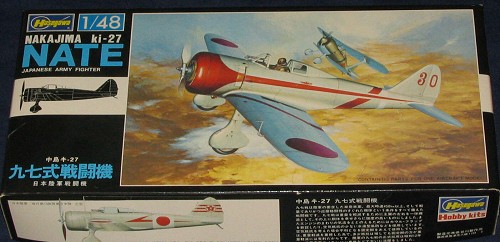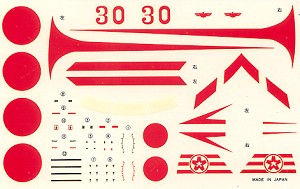
| KIT: | Hasegawa 1/48 Ki-27 'Nate' |
| KIT #: | U 1 |
| PRICE: | $ |
| DECALS: | Two options |
| REVIEWER: | Scott Van Aken |
| NOTES: | One of the old Mania kits. |

| HISTORY |
The IJAAF's first monoplane fighter was the Ki-27. Developed in the mid 1930s at the same time when Supermarine was developing the Spitfire and Messerschmitt the 109, Nakajima's design was a bit less advanced than its European equivalents. This was due to a differing philosophy that was held by the Japanese that the ability to dogfight was of paramount importance. While this held them in good stead during the early days of WWII, it was one that doomed thousands of Japan's pilots.
The main reason was that to get the sort of handling that the pilots demanded, certain things like armor plating and fuel protection were eliminated to reduce weight. This even resulted in the Ki-27 having fixed landing gear as high speed was not considered important enough. However, moving from the biplane Ki-10 to the monoplane Ki-27 did provide a considerable increase in velocity from what has been the norm.
The Ki-27 saw a great deal of action in Japan's wars prior to the Pacific War. In both China and against the Soviets in Manchuria, the Ki-27 bore the brunt of the action in the air. Many Japanese pilots were able to score impressive numbers of victories and soon became household names in the homeland. It was towards the end of the Manchurian war, when the Russian I-16 was introduced that the Japanese had trouble. The I-16 was faster and some had better armament than the Ki-27s rifle calibre machine guns. This was brought even closer to home when the Pacific War started and they were up against more heavily armed British and US aircraft in China and Southeast Asia.
Eventually the aircraft were replaced by the Ki-43 (which still carried over several of the Ki-27s faults in terms of light construction and weak armament). The Ki-27 was then relegated to homeland defense, areas like Formosa and Manchuria which had become 'backwaters', and to advanced fighter training schools. Only one airframe is known to exist and it was pulled out of the Inland Sea back in the late 1990s.
| THE KIT |
 Hasegawa's
Ki-27kit is actually one of the old Mania molds. When Mania went out of
business in the 1970s, Hasegawa purchased their stock and in it were
included some 1/48 kits including a N1K2-J 'George', an F4U-4
Corsair, and this Ki-27. Unlike the mainstream kits of the day, these Mania
kits have engraved panel lines as well as excellent detailing, especially
when you consider that the engineering is 30 years old.
Hasegawa's
Ki-27kit is actually one of the old Mania molds. When Mania went out of
business in the 1970s, Hasegawa purchased their stock and in it were
included some 1/48 kits including a N1K2-J 'George', an F4U-4
Corsair, and this Ki-27. Unlike the mainstream kits of the day, these Mania
kits have engraved panel lines as well as excellent detailing, especially
when you consider that the engineering is 30 years old.
The kit itself is molded in Hasegawa's somewhat hard light grey plastic. Since this is basically a pretty simple kit, there are not a ton of parts. You do get a complete cockpit with control stick, seat, rudder pedals, fire bottle and there is sidewall detail. The four part engine looks quite nice and some painting will enhance the detail given there. As for options, one is a bit limited. Basically, the only options are the use of the two fuel tanks under the wing and whether to use the early or the later canopy. While the canopy is a single piece, many pilots chose to fly without the sliding portion attached so to be properly accurate with some schemes, the canopy will need to be cut.
I should also mention that the mounting holes for the fuel tanks are already made so eliminating those will require the holes to be filled. One other thing is that when the Ki-27 was on the ground, the upper portion of the struts popped up through the upper wing. This has been shown properly on the kit so don't go cutting away the nubs that you see! Another interesting addition are two small exhaust-looking things that are shown extending from the starboard flap. I don't know what those are. The reference shows them in the drawings and they could also be under the port side. The vast majority of the photographs in the reference do not show these so it may be a good idea to leave them off and fill in the holes.
 My
kit is an older boxing and the instructions are in Japanese. They are
typical of what Hasegawa produced in the 70's in that the sheet is skinny
with 6 construction steps. Smaller subassembly instructions are along the
right margin. Color info is given but I can't decipher what is what. A full
color print of the two decal options is given. The first is the box art
plane from the 84th Dokuritsu Chutai in China during 1940. This
plane has the older canopy with the sliding portion removed. THe other is
from the 3 Chutai 13 Sentai in Japan during 1942 while on
home defense duties. Both aircraft are in overall Nakajima Grey. The decals
are most typical of what Hasegawa produced until just recently. They are
well printed, thick and the colors are off. The red is too bright and the
white is ivory. Despite being decades old, I'm sure they will still work
just fine. Most modelers will want to replace them with aftermarket decals
if they can find some.
My
kit is an older boxing and the instructions are in Japanese. They are
typical of what Hasegawa produced in the 70's in that the sheet is skinny
with 6 construction steps. Smaller subassembly instructions are along the
right margin. Color info is given but I can't decipher what is what. A full
color print of the two decal options is given. The first is the box art
plane from the 84th Dokuritsu Chutai in China during 1940. This
plane has the older canopy with the sliding portion removed. THe other is
from the 3 Chutai 13 Sentai in Japan during 1942 while on
home defense duties. Both aircraft are in overall Nakajima Grey. The decals
are most typical of what Hasegawa produced until just recently. They are
well printed, thick and the colors are off. The red is too bright and the
white is ivory. Despite being decades old, I'm sure they will still work
just fine. Most modelers will want to replace them with aftermarket decals
if they can find some.
| CONCLUSIONS |
This is such a nice kit that it is quite doubtful that you'll be seeing a more modern replacement. The kit has been reissued several times and even the older boxings are easy to find for around $10 or less. There are detail sets available for it if you wish to enhance it even more and thanks to its relatively simple construction, it should make for a beauty of a model when done.
| REFERENCES |
Nakajima Ki-27 'Nate', by Wieliczko & Szeremeta, Kagero, 2004.
You can find this kit and many others at

If you would like your product reviewed fairly and quickly by a site that has over 250,000 visitors a month, please contact me or see other details in the Note to Contributors.